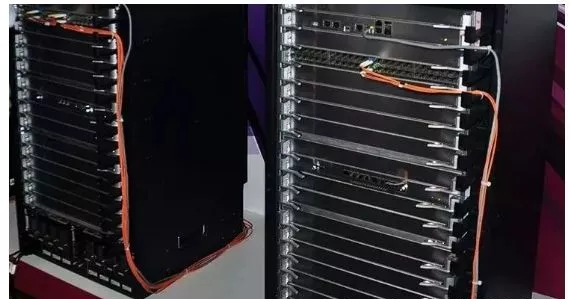100% Pass Cisco, PMP, CISA, CISM, AWS Dumps on SALE!
Get Now
01:59:56
X
CCIE R&S Lab, What are the factors that affect the core switch?
The main parameters of the core switch selection is scalability, forwarding rate, backplane bandwidth, four-layer switching, system redundancy and other parameters.
The core switches should all adopt a modular structure that must have a considerable number of slots, have strong network expansion capabilities, and can select modules of different numbers, different rates and different interface types according to actual or future needs. To adapt to ever-changing network requirements.
What are the factors that affect the core switch?
1, backplane bandwidth
The backplane bandwidth also known as the switching capacity. It is the maximum amount of data that can be handled between the switch interface processor or the interface card and the data bus. That just like the sum of the lanes owned by the overpass. Since communication between all ports needs to be completed through the backplane, the bandwidth that the backplane can provide becomes a bottleneck for concurrent communication between ports.
The larger the bandwidth, the larger the available bandwidth provided to each port and the faster the data exchange speed; the smaller the bandwidth, the smaller the available bandwidth for each port and the slower the data exchange speed.
We can say that the bandwidth of the backplane determines the data processing capability of the switch. The higher the bandwidth of the backplane, the stronger the ability to process data. If you want to achieve full-duplex non-blocking transmission of the network, you must meet the minimum backplane bandwidth requirements.
Calculated as follows:
Backplane bandwidth = number of ports × port rate × 2
prompt:
For a Layer 3 switch, only the forwarding rate and backplane bandwidth meet the minimum requirements which is a qualified switch and both are indispensable.
E.g:
How does a switch have 24 ports?
Backplane bandwidth = 24 * 1000 * 2 / 1000 = 48Gbps.
2. Layer 2 and Layer 3 packet forwarding rate
The data in the network consists of one packet and the processing of each packet consumes resources. The forwarding rate (also called throughput) refers to the number of packets that pass in a unit of time without packet loss. Throughput is like the traffic flow of an overpass which is the most important parameter of a three-layer switch and which indicates the specific performance of the switch.
If the throughput is too small, it will become a network bottleneck which will have a negative impact on the transmission efficiency of the entire network. The switch should be able to achieve wire-speed switching, ie the switching rate reaches the data transmission speed on the transmission line. Thus, minimizing the switching bottleneck.
For a three-layer core switch, if you want to achieve non-blocking transmission of the network, this rate can be ≤ nominal Layer 2 packet forwarding rate and rate energy ≤ nominal three-layer packet forwarding rate. Then, the switch is doing the second layer and the third .The line speed can be achieved when the layer is exchanged.

Calculation formula:
Throughput (Mpps) = number of 10 megabit ports × 14.88 Mpps + number of gigabit ports × 1.488 Mpps + number of 100 megabit ports × 0.1488 Mpps.
If the calculated throughput is less than the throughput of your switch, you can achieve line speed.
If there is a 10 Gigabit port and a 100 Mb port, if you have it, you can count it.
E.g:
For a switch with 24 gigabit ports, its full configuration throughput should be 24 x 1.488 Mpps = 35.71 Mpps to ensure non-blocking packet switching when all port line speeds are working.
Similarly, if a switch can provide up to 176 Gigabit ports, its throughput should be at least 261.8 Mpps (176 × 1.488 Mpps = 261.8 Mpps) which is the true non-blocking architecture design.
So, how is 1.488Mpps obtained?
The measure of packet forwarding line rate is based on the number of 64-byte packets (minimum packets) sent per unit time. For Gigabit Ethernet, the calculation method is as follows: 1,000,000,000bps/8bit/(64+8+12)byte=1,488,095pps Description: When the Ethernet frame is 64byte, consider the 8byte header and Fixed overhead of 12-byte frame gap. Therefore, the packet forwarding rate of a line rate Gigabit Ethernet port when forwarding a 64-byte packet is 1.488 Mpps. Fast Ethernet's speed port packet forwarding rate is exactly one-tenth of that of Gigabit Ethernet, which is 148.8kpps.
* For 10 Gigabit Ethernet, the packet forwarding rate of a wire-speed port is 14.88 Mpps.
* For Gigabit Ethernet, the packet forwarding rate of a wire-speed port is 1.488 Mpps.
* For Fast Ethernet, the packet forwarding rate of a wire-speed port is 0.1488 Mpps.
We can use this data.
Therefore, if we can meet the above three conditions (backplane bandwidth, packet forwarding rate) then we say that this core switch is truly linear and non-blocking.
Generally, the switch that both meets is the qualified switch.
The backplane is relatively large and the switch with relatively small throughput, in addition to retaining the ability to upgrade and expand, is a problem with software efficiency/special chip circuit design; the backplane is relatively small. For switches with relatively large throughput, the overall performance is relatively high. However, the bandwidth of the backplane can be trusted by the manufacturer. The throughput can not be trusted by the manufacturer. Because the latter is a design value that the test is very difficult and the meaning is not great.
3, scalability
Scalability should include two aspects:
1. Number of slots: The slot is used to install various functional modules and interface modules. Since the number of ports provided by each interface module is fixed, the number of slots fundamentally determines the number of ports that the switch can accommodate.
In addition, all functional modules (such as Super Engine Module, IP Voice Module, Extended Service Module, Network Monitoring Module, Security Service Module, etc.) need to occupy one slot, so the number of slots fundamentally determines the scalability of the switch. Sex.
2, module type: There is no doubt that the more supported module types (such as LAN interface module, WAN interface module, ATM interface module, extended function module, etc.), the more scalable the switch. For example, the LAN interface module should include RJ-45 modules, GBIC modules, SFP modules, and 10 Gbps modules to meet the needs of complex environments and network applications in large and medium-sized networks.
4, four-layer exchange
Layer 4 switching is used to achieve fast access to network services. In Layer 4 switching, the decision is based on not only the MAC address (Layer 2 bridge) or the source/destination address (Layer 3 routing), but also the TCP/UDP (Layer 4) application port number which is designed. Used in high speed intranet applications.
In addition to the load balancing function, Layer 4 switching supports transport stream control based on application type and user ID. In addition, the Layer 4 switch is placed directly on the front end of the server which understands the application session content and user rights, making it an ideal platform to prevent unauthorized access to the server.
5, module redundancy
Redundancy is the guarantee for the safe operation of the network. No manufacturer can guarantee that its products will not malfunction during operation. The ability to switch quickly when a failure occurs depends on the redundancy of the device.
For the core switch, important components should have redundancy, such as management module redundancy, power supply redundancy, etc., so as to ensure the stable operation of the network to the greatest extent.
6, routing redundancy
The HSRP and VRRP protocols are used to ensure the load balancing and hot backup of the core devices. When a switch in the core switch and the dual aggregation switch fails, the Layer 3 routing device and the virtual gateway can quickly switch to implement dual-line redundancy backup. Ensure the stability of the whole network.
The above article is from PASSHOT, PASSHOT can help you pass CCIE WRITTEN EXAM and CCIE R&S EXAM once and help you get your CCIE certificate. If you need to reprint, please indicate the source!
Cisco Dumps Popular Search:
ccna 200 301 online training how to pass ccie security written ccna security test dump cisco online exam answers ccna 200 301 torrent ccnp route 300-101 drag and drop ccie data center version 2 lab ccie ccna latest syllabus 2016 pdf ccie routing and switching lab exam format
Copyright © 2025 PASSHOT All rights reserved.






